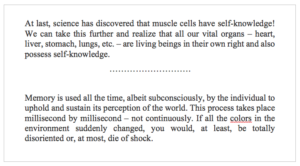This article was first published in "Going Mental" by Daniel McGowan.
Constructive Awareness
In my book “CONSTRUCTIVE AWARENESS”, I wrote, “We require a totally new language to discuss the self, because our way of referring to it is historically based on the common belief that the body is a material object.”
This is why I have given the title “MENTALISTICS OF THE SELF” to the chapter that deals with the apparently physical body as a mechanism. But despite the attempt to change our habitual use of words to describe the human entity, I have the uneasy feeling that the chapter gives the impression that s/he functions like some kind of sophisticated machine and the description is too dry, too mechanical. For example, “we can attach a piece of string or elastic to the lower leg to stop it from falling over.” The human being, however, bears no resemblance to a machine, because the former is a miraculous entity capable of thinking, feeling and willing. S/he is a vibrant, sentient and beautiful creature who expresses the unfathomable energy behind the universe – namely the World-Mind – in a way that no machine can. S/he is made up of thoughts, emotions, and creativity that a machine does not posses. And the Life-Force, Spirit-Energy, Kundalini – call it what you will – flows through her in a far different way from a machine.
It is not enough, therefore, to describe the spine’s ability to lengthen purely as a function of the amount of fluid in the intervertebral discs. The spine, like the rest of the so-called body, is vivified by this mysterious, awesome power – the Kundalini – that flows spiral-fashion upwards like a coiled serpent. The Kundalini is a manifestation of the World-Mind’s thinking. Each of us is a thought-form in the World-Mind. Each of us is a form of Consciousness.
As forms of Consciousness, we are capable of giving attention, capable of self-knowledge, capable of thinking and capable of forming our own private percepts and concepts of the world around us. We are inherently curious, capable of applying introspection, capable of analyzing, pondering, capable of feeling emotions from the highest ecstasy to the deepest despair and capable of creating all kinds of things, from the beauty of inspired art to the horror of the atomic bomb. These are some of the other mentalistics of the self.
So here we have this sentient entity, this “I”, that can say:
I – as mind – am.
I – as mind – am giving attention.
I – as mind – am thinking.
I – as mind – am aware that I am.
I – as mind – am forming percepts and concepts.
I – as mind – am examining my own thoughts.
I – as mind – am analyzing.
I – as mind – am feeling this or that emotion.
I – as mind – am creating.
If the individual were to keep in mind, the phrase – “as mind” – every time s/he uttered the words “I am,” then s/he would move away from materialistic and possessive phrases such as, “I have changed my mind”, or “In my mind, I thought this or that.” The expression “I have changed my mind”, is rooted in, and keeps one habitually steeped in, materialism. It implies a physical entity that possesses a mind.
This is not so, you are a mind. As a mentalist, you would say “I – as mind – have changed my thinking” or “I – as mind – have changed my opinion”.
It would not, of course, be necessary to keep repeating the phrase – “as mind”. Conversely, however, to do so is not such a bad idea, because we greatly underestimate the power of habitual use of certain familiar phrases to not only affect, but also to form our version of reality. Hence the power of the materialistic phrase “I have changed my mind”, to keep us immersed in illusion.
Incidentally, I love the way the activities of the self are expressed in the English language when we say such things as, “I am thinking”, or “I am doing” or “I am laughing”, etc., where, in the phrase “I am”, we constantly, but unwittingly, re-state our existence as individuals. The ”ing” in thinking, doing, or laughing, etc., gives a beautiful feeling of the Now, the Ever-Present Moment that the Wise Wo/men of the World exhort us to be in, to live in. A wee pause between “I am” and “thinking” etc., would remind one that, as mind, “I am – thinking” etc. “I am” is infinite, held in eternity: “thinking, or doing, or laughing etc.”, is transient.
Referring back to the Life-Force, Spirit-Energy, or Kundalini, a word of warning is necessary at this point. If you have ever experienced the sudden release of the Kundalini up your spine, you will know that it is a breath-taking, irrepressible force. It is a fiery power that should not be meddled with; should not be sought after directly in the belief that its appearance is a mark of progress on the spiritual quest.

This article was first published in Going Mental by Daniel McGowan. You can download the PDF of this book for free here: FREE DOWNLOAD